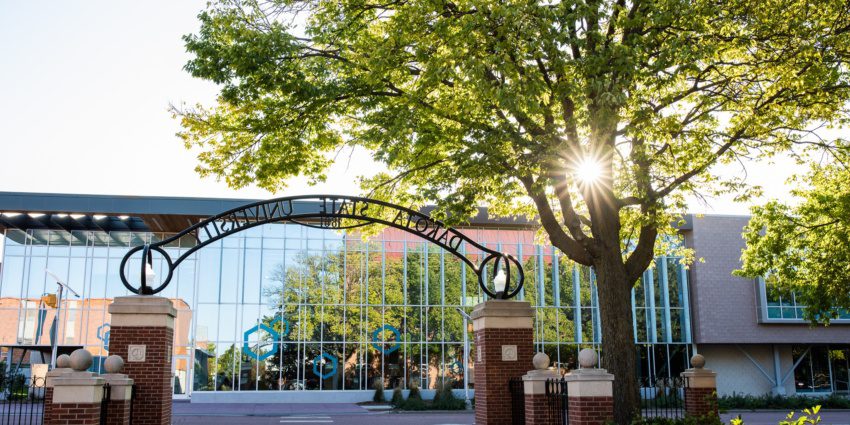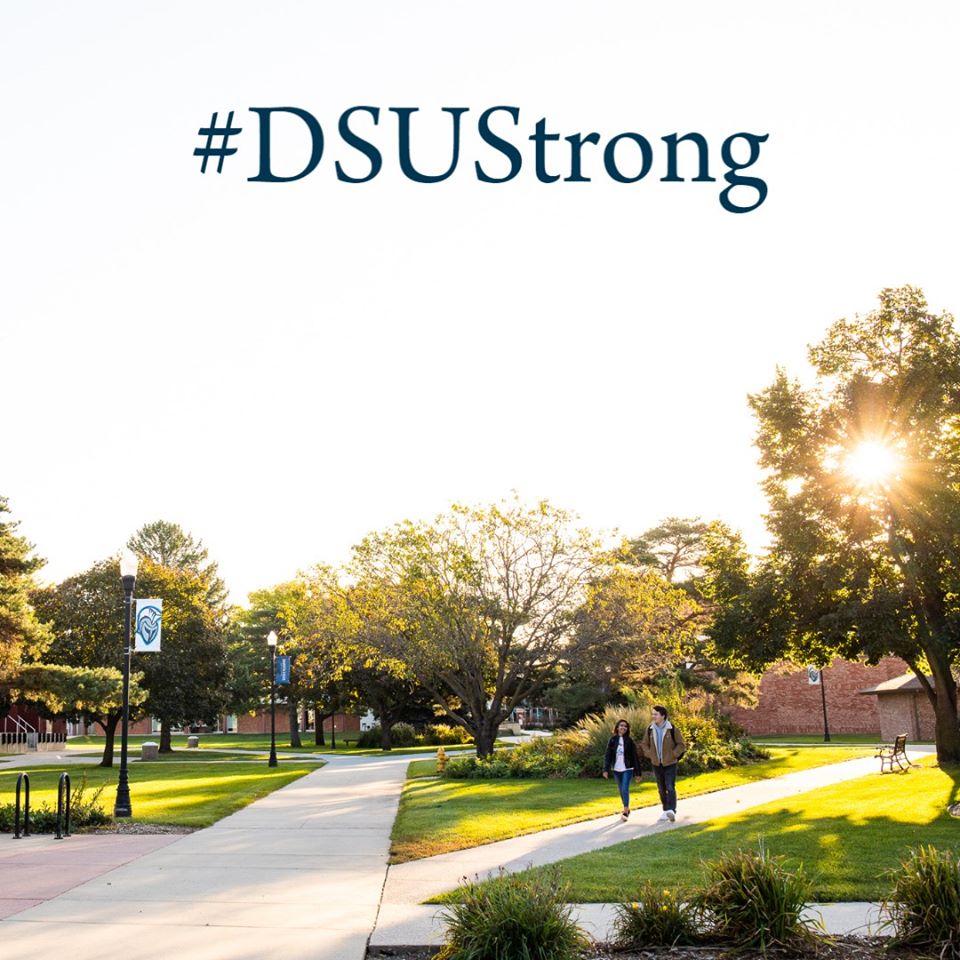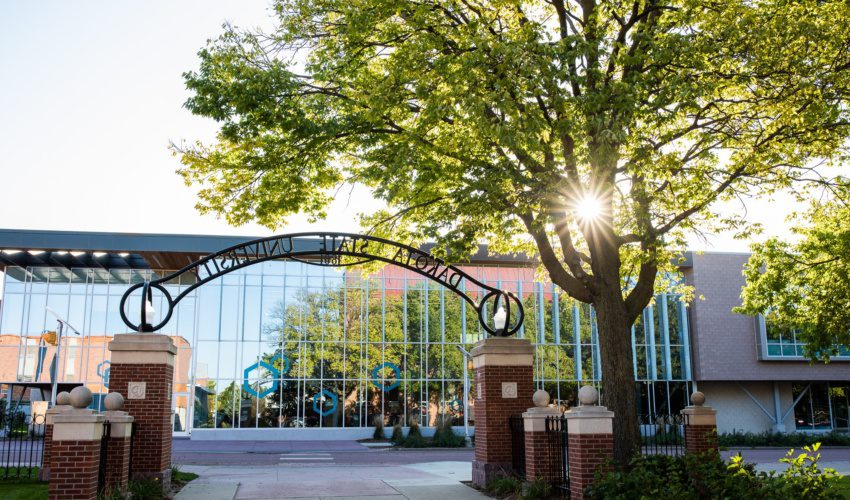Remote learning at DSU: ‘The more things change, the more they stay the same’
April 23, 2020
This paid piece is sponsored by Dakota State University.
The COVID-19 pandemic has forced many organizations to change the way they work. Dakota State University was one of many who were thrust into shifting their operations to online formats so everyone – students, faculty and staff – could work remotely from home.
DSU made the move without missing a beat. That was possible through focusing on all the things that have contributed to its rise over the past few years – the planning, preparation, collaboration and forward vision that has shifted DSU from being “The Little University on the Prairie” to the “Cyber Powerhouse of the Plains.” A lot changed, but a lot also stayed the same.
“I think even we were impressed by how well things went,” said DSU president José-Marie Griffiths.
“This pandemic has obviously been disruptive for almost everyone, professionally and personally. And we understand that a great many individuals and families, businesses and organizations are still struggling to figure out how to manage in this situation. We are fortunate that at DSU we moved early, back in January, to consider potential impacts for the university if COVID-19 hit here. That planning and advanced preparation, our strengths in cyber and technology, and all of the remarkable people who are the heart and soul of DSU made it possible for the university to move to remote operations quickly and efficiently.”
However, that is not to say DSU’s shift was without a lot of work and effort. For a few weeks, DSU was like a swan seemingly effortlessly gliding along the surface of the water away from a barking dog on the shore. At the same time, under the water, its feet were paddling like crazy to move itself to safety.
“We recognize that we have some advantages that others didn’t have,” Griffiths continued.
“We have students and employees who are tech-savvy, a leading-edge campus technology infrastructure, most faculty and students familiar with online classes and highly skilled IT support staff. All those elements were definitely in our favor. On the other hand, between all of our employees and students, we have the equivalent of a small city. Almost overnight, we had to move everyone and their activities, along with their belongings or work equipment and materials, off campus to other locations. The logistics of it all were significant, and we definitely needed all hands on deck to make it work.”
DSU has a long legacy of continuous quality improvement, so DSU leadership and departments are used to collaborative problem-solving processes. When Gov. Kristi Noem announced that all state activities were to move to remote work, DSU was ready with plans to make the shift.
The president’s Cabinet, the university’s leadership team, was augmented with a coronavirus task force with representatives from key departments and activities across campus. These two groups immediately began daily, in-person meetings with simultaneous videoconferencing via Zoom for those who had already moved to working from home because of being at high risk for COVID-19. The teams worked their way through the lists of items that had to be addressed.
The issues were multilayered and detailed, and included things like ensuring that employees had the necessary computer equipment and accessible files they required to keep doing their jobs from home, and scheduling times and assistance for students to return to campus and move their belongings out of the residence halls – with the added constraint of maintaining appropriate physical distancing and other COVID-19 precautions.
Communication to all of DSU’s multiple constituents was also key to the university making an efficient transition. DSU’s marketing department took the lead in coordinating all major communications to ensure consistency, sending out almost daily internal memos and external press releases, sometimes even more than once a day. They also posted frequent updates on DSU’s website, right at the top of the homepage, clearly marked with a date and time to make it clear when new information was provided.
In addition, they set up and staffed a university coronavirus hotline, available each weekday, to provide a central, easy access point for questions related to DSU’s migration. Questions that came in that were not related specifically to DSU were connected with the appropriate state resource, for example, the South Dakota Department of Health coronavirus information line. Individual departments and activities were encouraged to also communicate with their members frequently and clearly, so that everyone was clear about plans, expectations and available supports.
While the teams no longer need to meet as frequently, they are continuing to meet regularly to ensure that DSU has contingency plans in place should further operational changes be needed in the next academic year beginning in the fall.
While all of this activity was necessary and important, the values and main concerns of DSU never shifted.
“Our first priority is always the well-being and safety of everyone in our DSU community,” Griffiths said. “That doesn’t change whether we are working on campus or at home or even outer space, if need be. Our people are our greatest strength and our greatest asset. Higher education exists to advance and enrich the lives of our students and to advance and enrich the life of the people in our communities and our world through scholarship, research and public service. Thus, everything we do, whether on campus or online or at remote locations, wherever, is focused on doing that effectively and efficiently in ways that work well both for the people we serve and our employees.”
Working on campus together, students and employees develop a sense of community, with nurturing interactions and friendships. Moving to working remotely, those regular naturally occurring social interactions have been disrupted.
As Griffiths pointed out: “At the same time, all of our other traditional social structures have been suspended as well. From churches to clubs, athletic events to community celebrations, our regular rhythms of social connectivity and interaction have suddenly stopped.”
DSU moved quickly to put in place new ways for employees to continue to connect and interact in meaningful ways. The university considered “How can technology help us stay together?” DSU has developed ways to address the human element, using technology to build and sustain a community in creative ways.
The human resources department has put in place several engagement techniques through weekly emails and a private employee Facebook page called Trojans Helping Trojans. These feature daily discussion topics, spirit-building dress-up themes, virtual lunches and online games to help employees feel connected. There is also a weekly virtual meeting called What’s Up DSU?
“We have to be deliberate to retain those opportunities to interact that we have when we physically work together,” Griffiths said. “Maybe we’ll become more deliberate about these interactions when we come back to campus, and we might never take them for granted again.”
A sense of community is important with online instruction as well.
“It’s more than just having a laptop and going online. The aim is to use the opportunity to learn how to build and sustain community in an online class,” she said.
Having taught online classes herself, “I know it can be done,” Griffiths said. “It’s best to have a combination or synchronous and asynchronous experiences and use creative ideas for group work and projects.”
Lessons to be learned, future changes
Even with experience and readiness, DSU encountered a few technology issues that faculty and Information Technology Services, or ITS, staff had to work through, Griffiths noted. A few classes that are not usually offered online, such as in the arts/humanities subject areas, required some creativity on the part of faculty.
Then there were some very high-tech courses, such as animation labs, where students typically use specialized state-of-the-art equipment for their instruction. “The issue became how can we translate that highly specialized functionality into an online setting,” she said. ITS put in extra effort to work with the faculty members and vendors such as Adobe to provide what was needed.
“People talk about how this pandemic response has changed us forever, and in some respects, it has,” Griffiths said. “On the one hand, we may have developed more respect for technology,” she said, pointing out that some meetings that involve lengthy travel times may continue to take place through online conferencing methods, which work very well.
“But we also probably developed much more respect for the importance of social interaction, not just in the work environment but generally in our lives.”
For example, for 18- to 24-year-olds, the residential on-campus life experience “is an important way to grow up and develop social and leadership skills. The residential university experience extends much further than the classroom. Hopefully, we’ll resume the on-campus services and operations in the not-too-distant future,” she added.
In the meantime, DSU continues with its readiness planning in case fully online instruction and remote work continue in the fall. This will depend on many factors that will change higher education, but “it’s all about adapting, really,” Griffiths said. “Our mission and values haven’t changed. We’re just learning how to carry out our activities in new ways. DSU is still rising, and we will continue to rise. We are still #DSUStrong!”











